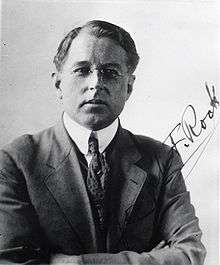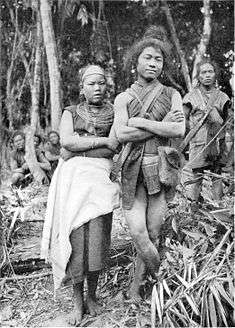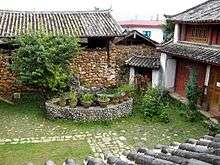Joseph Rock
| Joseph Francis Charles Rock | |
|---|---|
 | |
| Born |
1884 Vienna, Austria |
| Died |
1962 (aged 77–78) Honolulu, Hawaii, United States |
| Nationality | Austrian (by birth) |
| Citizenship | naturalized American (May 1913) |
| Alma mater | Vienna Schotten Gymnasium and Universität Wien. |
| Scientific career | |
| Fields | Botany |
| Institutions | Honolulu |
| Doctoral advisor | none |
| Other academic advisors | none |
| Doctoral students | none |
| Author abbrev. (botany) | Rock |
Joseph Francis Charles Rock (1884 – 1962) was an Austrian-American explorer, geographer, linguist and botanist.
Life
He was born in Vienna, Austria, went to Egypt at the age of 10 with his father, and later wandered about in Europe. But on an impulse, he emigrated to the United States in 1905 (New York) and moved to Honolulu, Hawaii in 1907, where he eventually became an authority on the flora there. He first taught full-time (there were two others) at Mills College (now known as Mid-Pacific Institute), and was placed on leave in Sept. 1908 for health reasons (he needed to be out-of-doors). As the Territory of Hawaii's first official botanist, he joined the faculty of the College of Hawaii; the name was changed in 1920 to become the University of Hawaii in 1911, established its first herbarium, and served as its first curator from 1911 until 1920, when he left the college to spend the next few decades exploring the botany of Asia.[1]


During the Ngolok rebellions (1917-1949) Rock witnessed repeated battles by the Ma Clique's Chinese Muslim army against the Ngolok Tibetans in Xiahe County and Labrang Monastery. The Ma Muslim army left Tibetan skeletons scattered over a wide area, and the Labrang monastery was decorated with decapitated Tibetan heads.[2] After the 1929 battle of Xiahe near Labrang, decapitated Tibetan heads were used as ornaments by Chinese Muslim troops in their camp, 154 in total. Rock described "young girls and children"'s heads staked around the military encampment. Ten to fifteen heads were fastened to the saddle of every Muslim cavalryman.[3] The heads were "strung about the walls of the Moslem garrison like a garland of flowers."[4]
In March 2009, the University of Hawaii at Manoa named its herbarium after him.[1] Works and collections by and from Rock are held in the Library of Congress.[5]
Plants named after him
The Hawaiian endemic species Lobelia rockii of Molokai, and Peperonia Rockii; Pandanus Rockii Martelli at Palmyra Atoll; the spectacular Rock's Tree Peony, Paeonia rockii from the Gansu mountains of western China, and the yellow-berried mountain-ash Sorbus 'Joseph Rock'[6] are named after Rock.
Works
In 1916, Rock wrote the principal scientific description of Palmyra Atoll in the central Pacific Ocean. In his later expeditions and studies in China, Tibet and the eastern Himalayas, he produced a 1,094-page dictionary, numerous scholarly papers, and two histories of the Nakhi (Naxi) people and language of northwestern Yunnan, which have been widely used for the study of Nakhi culture, language and religion. These books are out-of-print and, consequently, command very high prices in the rare book markets.
The most important of his written works are
- Palmyra Island with a Description of its Flora, Honolulu, 1916.[7]
- The Ancient Nakhi Kingdom of Southwest China. 2 vols., illustrated. Cambridge, Mass.: Harvard Univ. Press, 1948.
- A Nakhi-English encyclopedic dictionary. Rome: I.M.E.O., 1963.
- His National Geographic magazine articles:
- "Hunting the Chaulmoogra tree" (1922) 3:242-276 (Also published separately).
- "Banishing the Devil of Disease Among the Nashi: Weird Ceremonies Performed by an Aboriginal Tribe in the Heart of Yunnan Province" (1924) 46:473-499
- "Land of the Yellow Lama: National Geographic Society Explorer Visits the Strange Kingdom of Muli, Beyond the Likiang Snow Range of Yunnan, China" (1924) 47: 447-491
- "Experiences of a Lone Geographer: An American Agricultural Explorer Makes His Way through Brigand-Infested Central China En Route to the Amne Machin Range, Tibet" (1925) 48: 331-347
- "Through the Great River Trenches of Asia: National Geographic Society Explorer Follows the Yangtze, Mekong, and Salwin Through Mighty Gorges" (1926) 50: 133-186
- "Life among the Lamas of Choni: Describing the Mystery Plays and Butter Festival in the Monastery of an Almost Unknown Tibetan Principality in Kansu Province, China" (1928): 569-619
- "Seeking the Mountains of Mystery: An Expedition on the China-Tibet Frontier to the Unexplored Amnyi Machen range, One of Whole Peaks Rivals Everest" (1930) 57:131-185
- "Glories of the Minya Konka: Magnificent Snow Peaks of the China-Tibetan Border are Photographed at Close Range by a National Geographic Society Expedition" (1930) 58:385-437
- "Konka Risumgongba, Holy Mountain of the Outlaws" (1931) 60:1-65
- "Sungmas, the Living Oracles of the Tibetan Church" (1935) 68:475-486.
See also
- Gongga Shan, a mountain in Sichuan which (due to poor measuring equipment) Rock erroneously thought for a time to be the highest in the world.
References
- 1 2 "Botanist, famed explorer honored at UH Manoa: Herbarium to carry name of Joseph F. Rock". 2009-03-06. Retrieved 2009-03-16.
- ↑ Dean King (2010). Unbound: A True Story of War, Love, and Survival (illustrated ed.). Hachette Digital, Inc. ISBN 0-316-16708-8. Retrieved 2010-06-28.
- ↑ Paul Hattaway (2004). Peoples of the Buddhist world: a Christian prayer diary. William Carey Library. p. 4. ISBN 0-87808-361-8. Retrieved 2011-05-29.
- ↑ Gary Geddes (2008). Kingdom of Ten Thousand Things: An Impossible Journey from Kabul to Chiapas (illustrated ed.). Sterling Publishing Company, Inc. p. 175. ISBN 1-4027-5344-6. Retrieved 2011-05-29.
- ↑ "Biographical Records of the Royal Mu Family". World Digital Library. 1931. Retrieved 2013-06-20.
- ↑ Royal Horticultural Society: Sorbus "Joseph Rock"
- ↑ Joseph F. Rock (April 1916). "Palmyra Island with a Description of its Flora". Bulletin Number 4. Honolulu: College of Hawaii.
Further reading
- Chock, Alvin K. 1963. "J. F. Rock, 1894-1962." Taxon 12(3):89-102.
- Michael Aris (1992) "Lamas, Princes, and Brigands. Joseph Rock's Photographs of the Tibetan Borderlands of China", China Institute in America, New York City
- Sutton, S.B. (1974) "In China's Border Provinces: The Turbulent Career of Joseph Rock, Botanist Explorer", New York
- Gore, R. (1997) "Joseph Rock (1922-1935): Our Man in China" National Geographic Magazine 191: 62-81
- Goodman, Jim (Caravan Press 2006) "Joseph F. Rock and His Shangri-La"
- Frain, Irène (Fayard 2006) "Au Royaume des Femmes", ISBN 978-2213622590, notice bnf 40999356
- Frain, Irène (Maren Sell 2007) "A la recherche du Royaume", ISBN 978-2-35004-070-7, notice bnf 41008902
- Film: "A King in China" - A People and Places Production © 2003, Paul Harris (director)